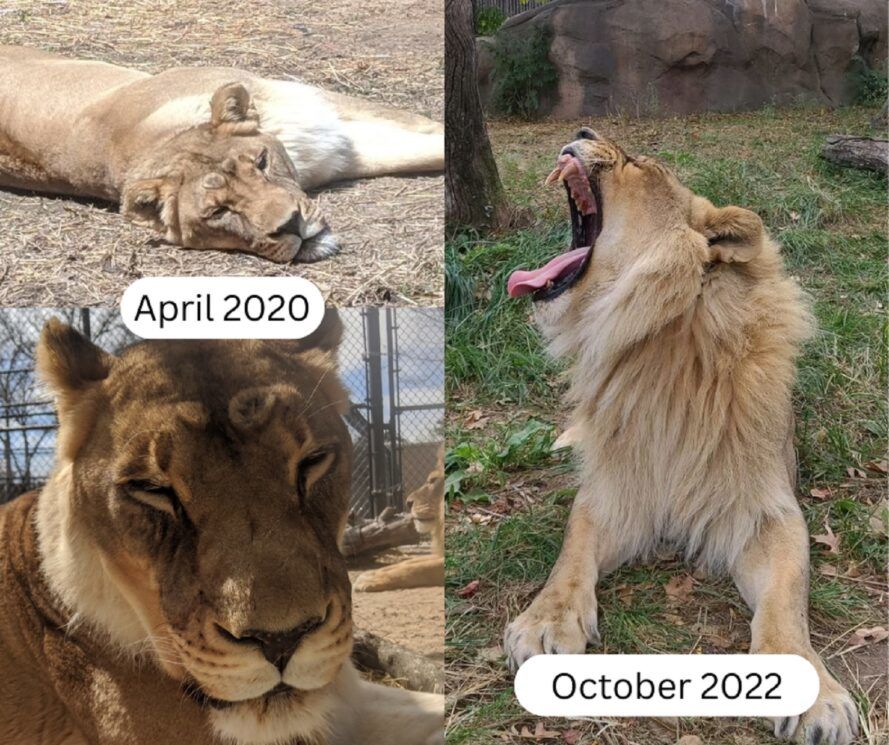
Kansas lioness suddenly grows a mane at the Topeka Zoo
A strange thing has happened in the Topeka Zoo. Zuri, a full grown lioness, has grown a mane.
Continue reading below
Our Featured Videos
A female lioness growing a mane is an extremely rare, though not unique, phenomenon. In 2011, zookeepers at the National Zoological Gardens of South Africa noticed that Emma, a captive lioness, had developed a mane. Her transformation was traced to an ovary problem causing high testosterone levels. After an operation, she reverted to more feminine ways.
Related: Best places and practices for your next big cat tourism

In 2016, researchers in Botswana observed five lionesses who sprouted manes and began acting like guys, roaring and even mounting other females. Scientists hypothesized that these lionesses, too, were experiencing an influx of testosterone.
“While some of the maned lionesses were observed mating, none of them became pregnant, suggesting they are infertile, a known consequence of high levels of androgens such as testosterone in females. The behavioral changes suggest this is likely the case,” said Kathleen Alexander, a wildlife scientist who has worked in Africa for more than 20 years, as quoted by New Scientist.
But what’s with Zuri? Why has this Kansan lioness taken on a new gender? Is she the king or queen of the jungle, or does she need a new pronoun? And will her mane remain, or will her gender fluidity continue to evolve? Shanna Simpson, an animal curator at the Topeka Zoo and Conservation Center, shared her insights and theories with Inhabitat.

Inhabitat: Why do you think Zuri has grown a mane?
Simpson: Zuri began growing excess fur around her head following the death of the only male lion in the pride, Avus, in October 2020. Around one to two months later, Zuri also started to grow longer patches of fur around her nape. We believe she is taking on his role as the protector of the pride because the mane’s purpose is to protect lions’ necks from attackers. In Botswana, there was a pride of lionesses, four or five of them, who developed manes and were studied by scientists. They found that they did in fact show increases in their testosterone levels and showed signs of being the protectors of the pride. Overall, we believe that Zuri might be taking on a “protector role” for her and her sister.
Inhabitat: How has her behavior changed?
Simpson: In the days after Avus passed away, we noticed unusual behavior in Zuri and her sister, Asante. They were more skittish, jumpy and not eating as much. They were always very confident cats. This only lasted a few days as they settled into their new routine without Avus. However, Zuri has always had a strong personality and has more or less run the pride even when Avus was around. She’s a very dominant female. She always has been and she’s kind of in charge. She’s the feistier one. Zuri and Asante have since returned to their normal life and have been thriving for their older age.
Inhabitat: How many lions are in the zoo and how are the others reacting to her?
Simpson: Zuri and her same-aged sister Asante arrived at Topeka Zoo in 2006 and are currently the only members of their species there.
Inhabitat: Are you going to get another male lion?
Simpson: We will eventually get a male lion. It is hard to predict how Zuri will respond. It could go one of two ways: Zuri accepts the new male into her pride and possibly loses the mane, or she will challenge the male as the leader of her pride. Whatever happens, we will provide the best welfare that we can and let them dictate how they want to settle in.

Inhabitat: Has Zuri’s mane attracted more zoo visitors?
Simpson: Zuri and the other lions have always been a favorite at the Topeka Zoo and Conservation Center. Zoo regulars have recently mistaken Zuri for a new male cat. You could say that Zuri is the talk of the town!
Inhabitat: What else should readers know about Zuri and lions?
Simpson: Lions are the only known big cats to form unique social structures. The females do most of the hunting and care for the cubs, while the males’ primary job is to keep rivals away and protect the pride.
This mane-growing phenomenon is extremely rare. However, it has been documented at the Oklahoma City Zoo and at Cameron Park Zoo, as well as in the Moremi Game Reserve in Botswana where five wild lionesses were reported with manes.
Aside from being good-looking, Zuri’s new mane doesn’t seem to be a sign of any health issues. Lions in the wild typically only live around 10 to 11 years old, while the median age for captive ones is about 14.5. Both Zuri and her sister are 18.5 years old.
